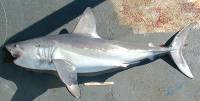 The porbeagle (Lamna nasus) is a species of mackerel shark in the family Lamnidae, distributed widely in the cold and temperate marine waters of the North Atlantic and Southern Hemisphere. The porbeagle typically reaches 2.5 m (8.2 ft) in length and a weight of 135 kg (298 lb); North Atlantic sharks grow larger than Southern Hemisphere sharks and differ in coloration and aspects of life history. Gray above and white below, the porbeagle has a very stout midsection that tapers towards the long, pointed snout and the narrow base of the tail. It has large pectoral and first dorsal fins, tiny pelvic, second dorsal, and anal fins, and a crescent-shaped caudal fin. The most distinctive features of this species are its three-cusped teeth, the white blotch at the aft base of its first dorsal fin, and the two pairs of lateral keels on its tail. The porbeagle is a very stout-bodied shark with a fusiform (spindle-like) shape. The long, conical snout tapers to a sharp point, and is supported by enlarged, highly calcified rostral cartilages. The eyes are large and black, without nictitating membranes (protective third eyelids). The small, S-shaped nostrils are positioned in front of and below the level of the eyes. The mouth is large and strongly curved, with moderately protrusible jaws. North Atlantic sharks have 28–29 upper tooth rows and 26–27 lower tooth rows, while Southern Hemisphere sharks have 30–31 upper tooth rows and 27–29 lower tooth rows. Each tooth has a strongly arched base and a nearly straight, awl-like central cusp, which is flanked by a pair of smaller cusplets in all but the smallest individuals. The five pairs of gill slits are long and precede the pectoral fin bases.
The porbeagle (Lamna nasus) is a species of mackerel shark in the family Lamnidae, distributed widely in the cold and temperate marine waters of the North Atlantic and Southern Hemisphere. The porbeagle typically reaches 2.5 m (8.2 ft) in length and a weight of 135 kg (298 lb); North Atlantic sharks grow larger than Southern Hemisphere sharks and differ in coloration and aspects of life history. Gray above and white below, the porbeagle has a very stout midsection that tapers towards the long, pointed snout and the narrow base of the tail. It has large pectoral and first dorsal fins, tiny pelvic, second dorsal, and anal fins, and a crescent-shaped caudal fin. The most distinctive features of this species are its three-cusped teeth, the white blotch at the aft base of its first dorsal fin, and the two pairs of lateral keels on its tail. The porbeagle is a very stout-bodied shark with a fusiform (spindle-like) shape. The long, conical snout tapers to a sharp point, and is supported by enlarged, highly calcified rostral cartilages. The eyes are large and black, without nictitating membranes (protective third eyelids). The small, S-shaped nostrils are positioned in front of and below the level of the eyes. The mouth is large and strongly curved, with moderately protrusible jaws. North Atlantic sharks have 28–29 upper tooth rows and 26–27 lower tooth rows, while Southern Hemisphere sharks have 30–31 upper tooth rows and 27–29 lower tooth rows. Each tooth has a strongly arched base and a nearly straight, awl-like central cusp, which is flanked by a pair of smaller cusplets in all but the smallest individuals. The five pairs of gill slits are long and precede the pectoral fin bases.
